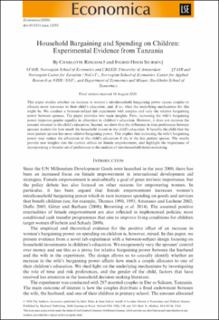Household Bargaining and Spending on Children: Experimental Evidence from Tanzania
Peer reviewed, Journal article
Published version
Permanent lenke
https://hdl.handle.net/11250/2721049Utgivelsesdato
2020Metadata
Vis full innførselSamlinger
- Articles (SAM) [119]
- Publikasjoner fra CRIStin (NHH) [249]
Originalversjon
10.1111/ecca.12353Sammendrag
This paper studies whether an increase in women’s intrahousehold bargaining power causes couples to
allocate more resources to their child’s education, and, if so, what the underlying mechanisms for this
might be. We conduct a between-subject lab experiment with couples and vary the relative bargaining
power between spouses. The paper provides two main insights. First, increasing the wife’s bargaining
power improves gender equality in allocation to children’s education. However, it does not increase the
amount invested in the child’s education. Second, we show that the difference in time preferences between
spouses matters for how much the household invests in the child’s education. It benefits the child that the
most patient spouse has more relative bargaining power. This implies that increasing the wife’s bargaining
power may reduce the allocation to the child’s education if she is the less patient spouse. The results
provide new insights into the current debate on female empowerment, and highlight the importance of
incorporating a broader set of preferences in the analysis of intrahousehold decision-making

